200 Words a Day! language learning. How the courses developed.

Bonjour! - Good morning! (in French)
Imagine you won't say Good
morning!
as you've hurt the BONE in your JAW!
The 200 Words a Day! language learning system has developed over some years. Here is the background to the course.
The system is simple, and has been developed and adapted from the teachings of some of the greatest memory masters in the world . . .
- Dominic O’Brien – World Memory Champion
- Tony Buzan – Mr Brain and the Master of Memory
- Dr Lozanov - Superlearning teacher who is world renowned for his contributions to language learning
- ....and many others...
We’ve used their secrets and woven them together in a new and revolutionary format to make learning the vocabulary of a new language easier for you than it has ever been.
No other language learning course is as powerful.
I have found no other language learning course where learning vocabulary is not sleep-inducing. I have seen no language learning course that is as effective at teaching foreign words, and teaching you how to remember them.
Not just learn them, but to remember them.
If you find any language learning course that comes close, do let me know . . . because in the meantime we are working on future versions and these will be better still!
But first, let me tell you a little about me and about how I developed the 200 Words a Day language learning course.
My name is Kevin Crocombe and I have always loved foreign languages, foreign words, and foreign accents, but it was not until later in life that I learnt the tools to quickly acquire words and vocabularly without being in a 'total immersion' environment.
Going to boarding school in New Caledonia, a French colony at age 11 I learned that the best way forward in language learning was the ‘total immersion’ approach, where you are totally immersed in the language.
As nobody spoke English at my boarding school, I had to learn French, and with everyone chattering away in French, plus living 24 hours around French people exclusively in a boarding school environment I was soon communicating in French. Within a few weeks I was writing my daily diary in French.
As kids are less worried about making mistakes, they tend to learn quicker, and be more natural at language learning, because they learn the rules 'on the hop' as they go, and accept things as they are and as they hear them.
On the other hand, adults when language learning are constrained by:
- the frameworks of the language they already have, even when in a total immersion situation.
- the fear or making a mistake and looking silly when speaking the language
- a desire for perfection, and not wanting to try until they have got everything exactly right (...I am not ready yet...)
- having passed puberty a native accent is more difficult to attain.
Kids also quickly develop a native accent, provided they have not passed puberty.
(...many a modern person is too totally immersed in work or study and other commitments to have the privilege of living in a country to enjoy language learning full time...)
For most of my childhood I lived in countries where different languages were spoken, in particular in Fiji where half the population, the indigenous Fijians spoke Fijian, and the other half of the population, the Indian descendants of indentured labourers, spoke Hindustani.
While I developed a full command in both languages of all the swear words and insults plus a basic repertoire of colloquialisms and day-to-day phrases – “how are you?”, “ what’s the time?”, “how much is it?”, “where are you going?” . . . I never gained any high degree of fluency.
Why?
Because everyone spoke English (…well the very colourful Fiji English complete with unique local accent). And also learning the vocab was just so much hard work, and boring. A pity nobody had invented the 200 Words a Day system then, or computers for that matter!
As a kid I took some lessons in both but had no success at real language learning… and no doubt many of you can relate to this . . .
. . . how many of you have forgotten about 90% of your school-learned languages?! Lots!
I decided in my thirties that I wanted to learn some German, my wife being fluent in Swiss German, but not having the time or ability to drop everything and go off and live somewhere to learn the language meant I had to resort to traditional language learning methods.
The result... not much language learning went on.
Trying to learn vocab was boring and difficult. Mind numbing.... and difficult to remember.
… but then I then came across…
…Paul Daniels’ Magic Memory casette tape language learning courses which first introduced me to the concept of using visualizations and word associations to learn a language.
He would tell you the English word, a German lady said the German equivalent, and then he’d explain a crazy visualization for you to remember the word by.
His technique was great and is basically what the memory masters teach.
(Many of you will have read some of the numerous books by Tony Buzan, Dr Bruno Furst or Dominic O’Brien all of whom teach fundamentally the same technique as Daniels).
Associating one known object with the object you are trying to learn, you then visualize a scene in your mind to lock the memory in place.
The crazier and more radical the scene, the easier it is to recall the word.
However, after going through a few hundred words, I soon found their language learning techniques have some . . .
. . . major drawbacks…. . .
. . . but I’ll come to those after I explain to you . . .
… the technique itself.
Take the English word ‘olive.’
Its Spanish equivalent is la aceituna, pronounced A-SAY-TUNA. It is a feminine noun.
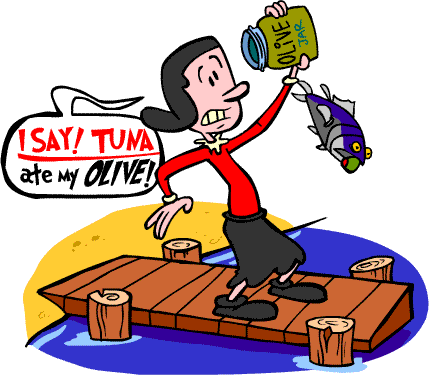
To assist memorising the word the language learning students are told to imagine in their minds’ eye a ‘mental movie’ that would trigger recall of the word.
First think of the subject. Imagine an olive about to be eaten by a lady (feminine gender) and A TUNA fish leaps out of the water and grabs the olive.
Imagine she then says, “I SAY TUNA ate my olive…!”
Bingo, you have a MEMORY TRIGGER visualized, and remember, the sillier it is, the easier it is to remember, the easier it is to recall and the longer you will remember it.
We call this little mental movie the Memory Trigger ©.
… It has Two Parts.
You might not have noticed but our ‘mental movie’ or Memory Trigger has 2 parts. As well as the scene to remember the word, and we have developed a method that overcomes that age-old problem of remembering the gender of a word.
If you’ve ever learned a European language, you’ll know exactly what I mean, and you’ll know the agony of never being sure if something is masculine, feminine or in the case of German neuter!
Have you ever experienced this, which is one of the tortures of language learning, the mental gymnastics when speaking the language, hoping the right gender would come out as you speak.
Well, no longer. . .
Part One is the memory jogger to help you remember the word or thing itself. This is the piece of the puzzle we call the Word Trigger ©.
Part Two is a memory jogger to indicate the gender of the word. We call this the Gender Trigger ©.
The two together form the Memory Trigger ©
. . . but for those who don't quite understand genders in language learning let us firstly talk a bit about . . .
. . . sex and language . . .
Because many European languages have genders, the Memory Trigger © needed a second part to it to help you remember the gender . . . (but do it without getting in to a two step process).
The gender is the ‘sex’ of a noun, a concept we English speakers dropped some hundreds of years ago. . . so that in English all our words are sexless or genderless.
Many other foreign languages however, attribute a sex or gender to the word, making them male, female or in some languages, neuter.
The word ‘the’ in English has two genders in Spanish.
1. It has a masculine (male) word ‘the’ – which is el.
2. It has a feminine (female) word for ‘the’ – which is la.
No rhyme or reason…
There is often no rhyme or reason as to how or why a word is masculine (male), feminine (female) (. . . or neuter in German. . .), and it is difficult for most students to remember which is which.
For example. A cat in Spanish is el gato. It is a masculine object, hence the word ‘el’ before it.
Yet, a butterfly is a feminine object, la mariposa.
Why they were chosen is pretty much an arbitrary thing, and it can be quite difficult as you cannot always remember the blasted genders.
Yes there are little rules that make it easier when language learning, but of course we know rules are made to be broken and this they do regularly.
So each ‘mental movie’ should have a memory jogger to help us remember the gender.
How have other experts tackled the teaching of genders?
The answer is that very few have any effective tool at all for this very important part of language learning!
They tell you to learn the gender with the word, which is fine, but it does not really give you much of a tool to use.
What Paul Daniels’ course did (for German) was, first, teach us the word, and . . .
. . .then . . .
. . . having learned the Word Trigger, he secondly, had us think of a separate scenario incorporating that visualization with:
- a little girl in each feminine visualization, and
- a boxer for each masculine visualization.
- (. . .for neutral words (German) he had us imagine a scene involving a fire. . . )
So it was a two step process.
This works fine for the first couple of dozen visualizations then I found that I had so many little girls and boxers in my mind ( . . . and fires . . .) . . . that there was soon little differentiation between them.
Before long, I found it difficult to remember any genders or words at all! The language learning process stalled.
Also because each word needed a two step visualization process (one for the word, then one for the gender), it doubles the workload.
So to learn 1,000 words, you actually need to have 2,000 visualizations in your language learning process. This also means twice as much work when revising.
We solve this two step problem, giving you 1,000 visualizations for 1,000 words, so you’ll find that much easier.
Master of Memory Tony Buzan, aka Mr Brain, in his book Master your Memory also teaches the same method of remembering the word, but does not address the issue of a gender trigger at all.
Not much help when every single noun in Spanish, French and German has a gender!
I adapted Paul Daniel’s language learning system but instead of having just a little girl for feminine words, and just a boxer for masculine figures, I expanded it to have . .
1. any unique female for feminine words (. . . a ballerina, a lady in a bikini, a milk-maid. . . ) and
2. any unique male for masculine words. (. . . a soldier, wrestler, man with a beard etc . . .)
Pretty simple. . .
. . . but there is even more yet . . .
I then further refined the technique with a clue thrown to me when I did the Memory Course of Dominic O’Brien the 8 times World Memory Champion.
O’Brien’s technique was similar to Paul Daniels’, in that he teaches you the visualization method to remember the word, then he teaches you a method to remember the gender.
He teaches you to put all the masculine words in to a certain location, and all the female words in a separate location.
Again, a two-step process. 1,000 words need 2,000 visualizations in the language learning process.
Given his world standing as a memoriser I have no doubt that his language learning technique is highly effective for him, but my brain needed an easier method. . .
. . . and so we developed an easier process. . .
One of the key concepts that O’Brien teaches is that we easily remember famous people.
He uses famous people for other memory tools, such as his system that enables him to remember over 40 packs of cards and memorise long lists of facts, dates and numbers.(I can thoroughly recommend his courses, they are excellent.)
And then it occurred to me . . . if O’Brien’s tool was so effective – and it is – I had an Archimedes experience…
EUREKA!…. it was obvious….
I figured we should use famous people as Gender Triggers©.
Simple…
So, you don’t just have a female ballerina or a lady in a bikini to help you remember the gender of a word. Where appropriate, where the person fits in some way with the word… we just add in a famous person. Add in a celebrity.
. . . Add a notorious criminal,
a sultry movie star,
a handsome actor,
a politician,
a philosopher.
So we might get you to visualize people such as . . .
George Clooney,
Ozzie Osbourne,
Al Capone,
Eminem,
Jennifer Lopez,
Mahatma Gandhi,
Abraham Lincoln,
Michael Jordan,
George Foreman,
Kylie Minogue,
Britney Spears,
Ronald Reagan….
. . . scores and scores of famous people all helping you to remember words during your language learning process.
It works brilliantly.
TO TRY IT FOR YOURSELF
SIMPLY CLICK
for your 200 Words a Day course!!
So let us look at some Spanish cases...
…el doctor - the doctor
– think George Clooney, the doctor in ER… He’s male, acts as a doctor, and it’s a masculine word.
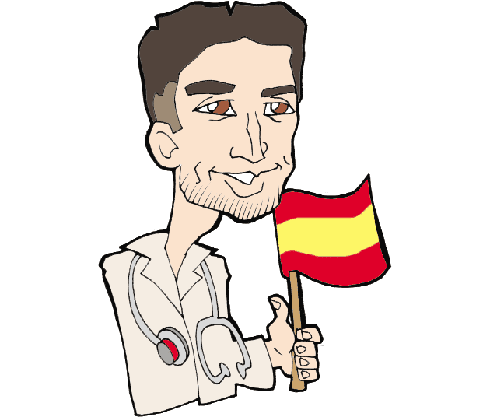
…for el baile
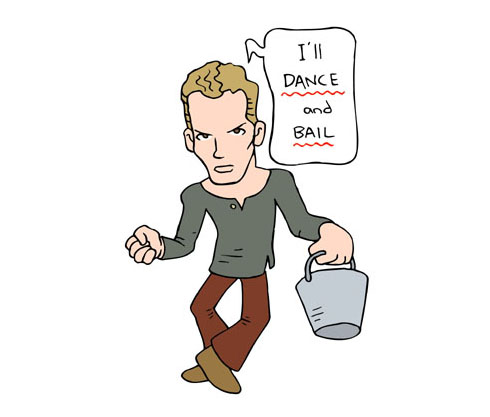
...which is Spanish for 'the dance', we think of Ricky Martin, whose hit song ‘Bailamos’ (literally ‘Let’s Dance’) provides us the link. Masculine again.
For feminine words, we use, where possible a famous female. . .
Remember the ‘olive’ example, aceituna, (pronounced A-SAY-TUNA…) where we imagine an olive about to be eaten by a lady, and A TUNA fish leaps out of the water and grabs the olive. She then says, “I SAY TUNA ate my olive…!”
Now imagine the woman is called Olive.
Easy huh!
But wait … there’s more yet to the 200 Words a Day language learning method...
. . .I hit a serious problem with all this dreaming away of visualizations when I was doing Paul Daniel’s language learning course because . . .
. . . daydreaming takes time and effort . . .
Each visualisation needed quiet time, concentrated time to relax and think of the scenarios he kindly provided.
(The other guys just provided the technique, and left it to you to figure out the Memory Triggers and visualizations for the words you wanted to learn).
Yes, it worked... kind of...
...but I found that with Paul Daniel’s German language learnig course I just ran out of time and interest, and had difficulty remembering the visualizations without going back to his tapes and starting again.
Yes, I kept forgetting the visualizations, and also whether there was a boxer or a little girl in the gender trigger.
Close, but no cigar!
…There had to be a better way….
... The answer soon became apparent to me.
What I needed was pictures of the visualizations.
That way I would not need to keep re-shooting my mental movies of all the words that I had forgotten, my mind being so clogged up with other things – like building and running a business, doing everything from driving a forklift to writing contracts, working a full-time job, and fitting in some family life.
I am sure many of you can relate to this, as the pace of life for most of you out there is hectic.
Even the modern school student has a schedule packed to fill every available minute! Not much extra time to dedicate to language learning.
Yes, pictures were the answer and obviously cartoons were the ideal pictures for language learning.
Cartoons because they can be crazy anyway. They’re fun, they have a licence to do anything, and we all love cartoons.
So that is what we have done. Created a cartoon for each and every word in the course.
The cartoons provide the visualization, taking all the ‘work’ out of shooting mental movies out of the equation… and believe me, lying back trying to dream up visualizations and shoot mental movies is time consuming work when language learning.
The concept ‘…a picture paints a thousand words…’ is proven 1,000 times with each 200 Words a Day language learning course!
The mind apparently has perfect recall for pictures and you get a snapshot visualization in seconds rather than having to relax and dream up a mental movie which really needs a good minute or so per visualization, if you want to lock in the visualization to your subconscious.
I chose 200 Words a Day Spanish because 'a picture paints a thousand words and this makes it easy to visualize the word and it certainly aids recollection.
The use of male and female voices when saying the word definitely helps in remembering its gender.
Mark Shelley, Richmond, England.
So it is about two to four times quicker! than trying to dream up your own visualization, plus we provide a ready means of storing the info!
Each cartoonist in our team from around the world – USA, UK, Australia, New Zealand, Brazil, Indonesia – has a unique and original style, illustrating each word with a cartoon of character and skill, many of them animated.
The sheer volume of work involved further reinforced for me how difficult it is, when language learning, to build vocabulary without pictures available to readily refer to. Each course has over 1,000 original pictures, with an illustration for each and every word.
The courses are easy and fun, and quick.
They all record your learning rate and track how you are doing on each and every word, so that you can concentrate on attacking the words you get wrong most often.
Try the 200 Words a Day language learning course, you have nothing to lose .... especially with our 365 Money Back Guarantee.
Order a 200 Words a Day! Language Course - Spanish, German, French, Italian and Welsh
Learn more about the 200 Words a Day! Accelerated Language Learning courses
200 Words a Day! Spanish Accelerated Language Learning courses
200 Words a Day! French Accelerated Language Learning courses
200 Words a Day! German Accelerated Language Learning courses
Language learning made easy the
200 Words a Day! way.
Learn Languages
200 Words a Day! and Exceltra
Copyright 2004-2022 All Rights Reserved.
Language learning made easy the 200 words a Day! way.
IMAGINE how you'd
FEEL
seeing yourself learning at a rate of 200 words a day ... the ideal companion course that complements any language course.
|





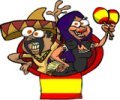
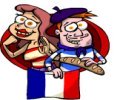



New! Comments
Have your say about what you just read! Leave us a comment in the box below.